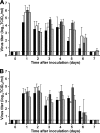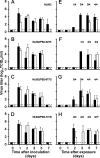Introduction of virulence markers in PB2 of pandemic swine-origin influenza virus does not result in enhanced virulence or transmission
- PMID: 20130063
- PMCID: PMC2849492
- DOI: 10.1128/JVI.02634-09
Introduction of virulence markers in PB2 of pandemic swine-origin influenza virus does not result in enhanced virulence or transmission
Abstract
In the first 6 months of the H1N1 swine-origin influenza virus (S-OIV) pandemic, the vast majority of infections were relatively mild. It has been postulated that mutations in the viral genome could result in more virulent viruses, leading to a more severe pandemic. Mutations E627K and D701N in the PB2 protein have previously been identified as determinants of avian and pandemic influenza virus virulence in mammals. These mutations were absent in S-OIVs detected early in the 2009 pandemic. Here, using reverse genetics, mutations E627K, D701N, and E677G were introduced into the prototype S-OIV A/Netherlands/602/2009, and their effects on virus replication, virulence, and transmission were investigated. Mutations E627K and D701N caused increased reporter gene expression driven by the S-OIV polymerase complex. None of the three mutations affected virus replication in vitro. The mutations had no major impact on virus replication in the respiratory tracts of mice and ferrets or on pathogenesis. All three mutant viruses were transmitted via aerosols or respiratory droplets in ferrets. Thus, the impact of key known virulence markers in PB2 in the context of current S-OIVs was surprisingly small. This study does not exclude the possibility of emergence of S-OIVs with other virulence-associated mutations in the future. We conclude that surveillance studies aimed at detecting S-OIVs with increased virulence or transmission should not rely solely on virulence markers identified in the past but should include detailed characterization of virus phenotypes, guided by genetic signatures of viruses detected in severe cases of disease in humans.
Figures






References
-
- Dawood, F. S., S. Jain, L. Finelli, M. W. Shaw, S. Lindstrom, R. J. Garten, L. V. Gubareva, X. Xu, C. B. Bridges, and T. M. Uyeki. 2009. Emergence of a novel swine-origin influenza A (H1N1) virus in humans. N. Engl. J. Med. 360:2605-2615. - PubMed
-
- de Jong, M. D., C. P. Simmons, T. T. Thanh, V. M. Hien, G. J. Smith, T. N. Chau, D. M. Hoang, N. V. Chau, T. H. Khanh, V. C. Dong, P. T. Qui, B. V. Cam, Q. H. Do, Y. Guan, J. S. Peiris, N. T. Chinh, T. T. Hien, and J. Farrar. 2006. Fatal outcome of human influenza A (H5N1) is associated with high viral load and hypercytokinemia. Nat. Med. 12:1203-1207. - PMC - PubMed
-
- de Wit, E., V. J. Munster, D. van Riel, W. E. P. Beyer, G. F. Rimmelzwaan, T. Kuiken, A. D. M. E. Osterhaus, and R. A. M. Fouchier. 2010. Molecular determinants of adaptation of highly pathogenic avian influenza H7N7 viruses to efficient replication in the human host. J. Virol. 84:1597-1606. - PMC - PubMed
-
- de Wit, E., M. I. Spronken, T. M. Bestebroer, G. F. Rimmelzwaan, A. D. Osterhaus, and R. A. Fouchier. 2004. Efficient generation and growth of influenza virus A/PR/8/34 from eight cDNA fragments. Virus Res. 103:155-161. - PubMed
Publication types
MeSH terms
Substances
Grants and funding
LinkOut - more resources
Full Text Sources
Miscellaneous

